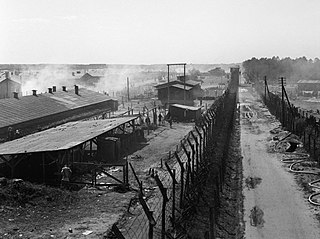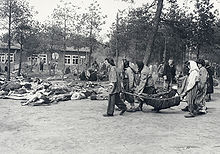
Bergen-Belsen, or Belsen, was a Nazi concentration camp in what is today Lower Saxony in northern Germany, southwest of the town of Bergen near Celle. Originally established as a prisoner of war camp, in 1943, parts of it became a concentration camp. Initially this was an "exchange camp", where Jewish hostages were held with the intention of exchanging them for German prisoners of war held overseas. The camp was later expanded to hold Jews from other concentration camps.

Brigadier Hugh Llewellyn Glyn Hughes, was a British military officer in the Royal Army Medical Corps and later a medical administrator, educationalist and sports administrator. Hughes served in both the First and Second World Wars and is notable for his role in the care and rehabilitation of the victims of Bergen-Belsen concentration camp.
Major-General James Alexander Deans Johnston, was a senior British Army officer in the Royal Army Medical Corps and the Senior Medical Officer at the liberated Bergen-Belsen concentration camp towards the end of the Second World War. A docudrama portraying his experiences attempting to save the starving and diseased concentration camp prisoners at Bergen-Belsen was made in 2007 entitled The Relief of Belsen.
Arnold Peter Meiklejohn was an English physician and academic, specializing in nutrition.
Alexander Paton was a British gastroenterologist, writer and postgraduate dean for North-West London hospitals, who was a specialist in alcohol misuse.
John Arthur Harland Hancock was a British venereologist and editor of the British Journal of Venereal Diseases who wrote on non-gonococcal urethritis and reactive arthritis, what was known as Reiter's disease at the time. In 1945, while studying medicine at the London Hospital, he was one of the voluntary students sent to Belsen to assist nutritionist Arnold Peter Meiklejohn in feeding the starving inmates. There, he became unwell with typhus and was treated back at The London by Lord Evans.
John Brian Walker was a British general practitioner with a prior career in eye surgery. After studying at New College, Oxford and while studying medicine at The London Hospital in 1945, he was one of the London medical students who were sent to Bergen-Belsen concentration camp shortly after its liberation by British troops, to assist in the feeding of the severely malnourished and dying inmates, under the supervision of nutritionist Arnold Peter Meiklejohn. After gaining his medical degree, he was drafted into the army and sent to east Africa, where he became an eye surgeon. Following demobilisation, he returned to London with his wife Mary and took on his father's general practice. Walker was also known for his skill in sailing with the Hornet dinghy fleet throughout the 1950s to 1970s.

Michael John Hargrave was a British general practitioner in Wootton Bassett, Wiltshire, who in 1945 assisted British Army occupation forces at the recently-liberated Bergen-Belsen concentration camp when he volunteered as a medical student from Westminster Hospital at the age of 21.

Dennis Henry Forsdick, was a British physician at the Friarsgate Medical Centre. In 1945, while studying medicine at Guy's Hospital, he assisted at Bergen-Belsen concentration camp as a voluntary medical student.

John Langford Hayward, was a British breast surgeon who researched treatment for advanced breast cancer. In 1945, while studying medicine at Guy's Hospital, he assisted with the Relief effort at Bergen-Belsen concentration camp as a voluntary medical student. He graduated in 1947.
David George Arthur Westbury was an English physician. He was described in his obituary by the Royal College of Psychiatrists as a "founding father of British forensic psychiatry". In 1945, while studying medicine at Guy's Hospital, he assisted at Bergen-Belsen concentration camp as a voluntary medical student.

Michael Gwynne Douglas Davys, was a British psychiatrist in Harrow on the Hill, who specialised in depression in children. In 1945, while studying medicine at Guy's Hospital, he assisted at Bergen-Belsen concentration camp as a voluntary medical student.

John Spencer Jones was a British chest physician. In 1945, while studying medicine at Guy's Hospital, he assisted at Bergen-Belsen concentration camp as a voluntary medical student. Here, he developed tuberculosis. He later authored a number of articles in medical journals including "Telling the right patient" in the British Medical Journal (1981), where he reported that 50% of people with terminal disease "want to know that this is so".

David Sells Hurwood was a British general practitioner in Syston and founder member of the Royal College of General Practitioners. In 1945, while studying medicine at Guy's Hospital, he assisted at Bergen-Belsen concentration camp as a voluntary medical student. Here, he developed tuberculosis.
Alan David Rowan MacAuslan, was a British doctor who in 1945, while studying at St Thomas' Hospital, assisted at Bergen-Belsen concentration camp when he volunteered as a medical student. In 2005, at the age of 83, his story was reported in the BBC News.
Peter William Gedge Tasker was a British general practitioner who performed some of the earliest studies of the causes of anaemia using radioactive tracer techniques. During his studies at The London Hospital in 1945, he was one of the London medical students who were sent to Bergen-Belsen concentration camp shortly after its liberation by British troops, to assist in the feeding of the severely malnourished and dying inmates, under the supervision of nutritionist Arnold Peter Meiklejohn. During the Malayan Emergency, he assisted by taking on the role as a pilot.
David Cordley Bradford (1922–2002), was a British general practitioner who founded the first purpose built surgery in Gloucestershire. In 1945, he was one of the volunteer London medical students from St Bartholomew's Hospital sent to assist at Belsen following its liberation by British troops.

After Daybreak: The Liberation of Belsen, 1945, is a book authored by Ben Shephard, published in 2005 by Jonathan Cape and Random House, in which he details the liberation of Belsen by British troops in April 1945.

Bergen-Belsen 1945: A Medical Student's Journal is Michael Hargrave's diary of his experiences providing medical assistance to the former inmates of Bergen-Belsen concentration camp between 28 April and 28 May 1945. It was written for his mother after he volunteered for the work while he was a student at Westminster Hospital Medical School in London. It is a typescript of the diary, which was originally hand-written, and begins with a foreword by the head of research at the Imperial War Museum and brief background notes by Hargrave's son David. Centre pages include photographs of the London medical students and the state of the camp, including the "human laundry".













